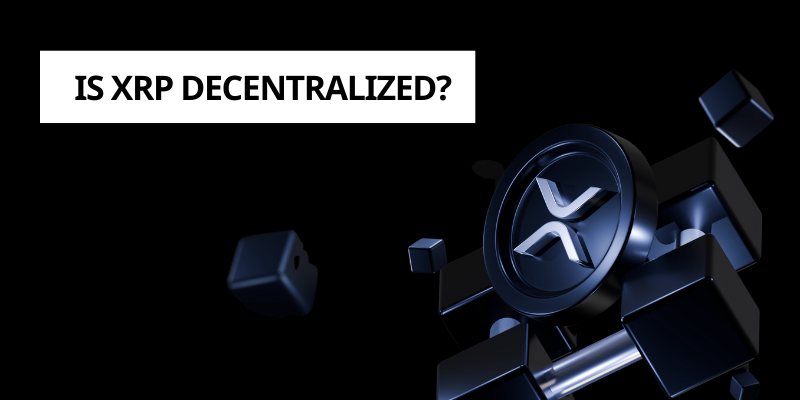Is XRP Decentralized? A Deep Dive into Ripple’s Consensus Model
The question Is XRP decentralized? cuts to the core of Ripple’s identity in the cryptocurrency ecosystem. As the native token of the XRP Ledger (XRPL), XRP powers a blockchain built for rapid, low-cost global payments—an ambition shared by projects like Voltix and Credible on Solana. Yet, its association with Ripple Labs, a for-profit company, sparks skepticism about its decentralized nature.
Contents
XRP and the XRPL: A Primer
Launched in 2012, the XRP Ledger is a public blockchain designed to rival SWIFT’s inefficiencies in cross-border payments. XRP, its native cryptocurrency, facilitates near-instant transactions with fees as low as $0.0002. Unlike Ethereum’s smart contract versatility or Solana’s high-throughput DePIN projects like Voltix, the XRPL prioritizes simplicity and speed. Its Consensus Protocol, distinct from proof-of-work or proof-of-stake, relies on validators to agree on transaction validity, raising the question: Is XRP decentralized enough to compete with permissionless blockchains?
Decentralization measures how control is distributed across a network. Bitcoin’s miners and Ethereum’s stakers embody this ideal, but XRP’s unique model—tied to Ripple Labs—requires closer scrutiny to determine if XRP decentralized holds true.

Why XRP is Considered Decentralized
Several factors support the argument that XRP decentralized is a valid claim:
-
Validator Network: The XRPL operates with over 150 validators worldwide, run by universities, exchanges, and individuals. Ripple Labs manages fewer than 5%, a stark improvement from its early dominance. This diversity strengthens the case for XRP decentralized.
-
Permissionless Access: Anyone can run a validator or develop on the XRPL without Ripple’s approval. This openness mirrors Solana’s ecosystem, where projects like Credible thrive on community contributions.
-
Escrowed Supply: Ripple holds roughly 40% of XRP’s 100 billion supply, but monthly escrow releases are transparent and predictable. This mitigates fears of market manipulation, a key concern when evaluating Is XRP decentralized?
-
Community Governance: Features like the Automated Market Maker (AMM), introduced in 2024, were voted on by validators, not dictated by Ripple. This decentralized decision-making aligns with blockchain’s ethos.
The Unique Node List (UNL), a subset of trusted validators, further decentralizes consensus by allowing nodes to choose their trusted peers. These traits suggest XRP decentralized is more than rhetoric—it’s a functional reality.
Challenges to XRP’s Decentralization
Skeptics, however, argue that XRP falls short of true decentralization:
-
Ripple’s Role: As the XRPL’s primary developer, Ripple wields significant influence. Its XRP holdings, even if escrowed, raise concerns about potential control, unlike Bitcoin’s leaderless structure.
-
Validator Dependency: While anyone can run a validator, the UNL’s trusted nodes drive consensus. Critics fear a scenario where Ripple-aligned validators could sway decisions, questioning whether XRP decentralized is fully achieved.
-
Institutional Focus: Ripple’s partnerships with banks and compliance-heavy approach contrast with crypto’s anti-establishment roots. The SEC case, though settled, reinforced perceptions of centralized oversight.
-
Historical Context: Early on, Ripple controlled most validators, a legacy that lingers in debates about Is XRP decentralized? despite recent progress.
These critiques resonate with broader blockchain discussions. Solana, for instance, faces centralization critiques over validator costs, yet projects like Voltix push for distributed networks. XRP’s journey reflects similar growing pains.

XRP’s Decentralization Spectrum
Answering Is XRP decentralized? requires context. The XRPL sacrifices some governance freedom for performance, processing 1,500 transactions per second versus Bitcoin’s 7. Its validator-based consensus avoids energy-intensive mining, appealing to eco-conscious investors, but relies on trust in UNL nodes. Compared to Solana’s 65,000 TPS or Ethereum’s staking model, XRP offers a middle ground—less decentralized than purist chains, but more practical for real-world use.
This balance is evident in projects like Credible, where KYC centralizes onboarding but token airdrops democratize access. Voltix’s DePIN rewards CPU contributors, decentralizing computing power much like XRP decentralizes payments. These parallels show that XRP decentralized is a matter of degree, not absolutes.
Investor Takeaways
For those weighing XRP’s place in their portfolio, the XRP decentralized debate has practical implications:
-
Market Potential: XRP’s efficiency drives adoption by firms like MoneyGram, potentially increasing its $1.30 price (April 2025). Decentralization progress could further boost confidence.
-
Risks: Ripple’s influence and regulatory scrutiny pose risks, though validator growth mitigates centralized control concerns.
-
Strategic Fit: If you value utility over ideological purity, XRP’s model aligns with projects like Voltix, prioritizing impact over dogma.
Looking Ahead
The future of XRP decentralized looks promising. Ripple’s plans to expand DeFi and NFT capabilities on the XRPL, coupled with growing validator adoption, signal deeper decentralization. Innovations from projects like Credible’s AI credit scoring could inspire XRP to integrate advanced features, enhancing its appeal. For now, XRP remains a hybrid—decentralized enough to disrupt finance, but pragmatic enough to partner with it.
In summary, Is XRP decentralized? yields a layered answer. The XRPL’s open-source design, diverse validators, and community-driven upgrades affirm its decentralized credentials, though Ripple’s shadow looms. For investors exploring airdrops like Credible or Voltix, XRP offers a lens into blockchain’s trade-offs. Embrace its potential, but stay vigilant—this is crypto, after all.